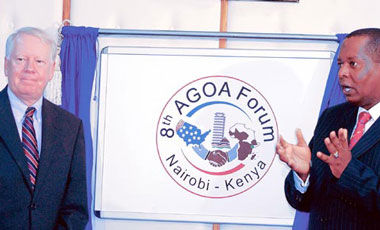
By Mubatsi Asinja Habati
But Ugandan exporters dismiss the US trade partnership
The 8th forum for the African Growth Opportunity Act (AGOA) held in Nairobi last week attracted a mammoth delegation that comprised the minister of trade, tourism and industry, Kahinda Otafiire, ministry officials and a group from the AGOA Country Response Unit.
Since then observers of Uganda’s experience with AGOA are questioning the relevance of Uganda’s representation at the forum. Uganda under AGOA trade partnership with the US has posted a dismal performance.
David Lule, director of Horticultural Exporters Association, says it is not profitable to export their products under AGOA.
“Growers in other countries produce high quality fruits and vegetables. Coupled with our less developed infrastructure we would not be very completive. This is not profitable for us,” he says.
He adds that because the horticultural products are highly perishable, they prefer doing the export business independently as the flight costs are equally high.
Stephen Isiko, secretary Federation of Uganda Exporters Association, agrees. He says most crops produced in Uganda do not meet the standards stipulated in the AGOA arrangement and only a few private exporters benefit from this Africa-US bilateral trade. Sending a delegation to the AGOA Forum in Nairobi implies the Ugandan tax payer financed the trip yet Uganda’s exports to the US through AGOA arrangement, have registered little success in as far as generating revenue is concerned. Oil comprises 92% of exports from Africa to the US and most African countries have not benefited from AGOA. Compared to Kenya, Madagascar and Mauritius, Uganda has had the worst deal from the trade partnership.
Uganda’s revenue from the AGOA exports is much lower than that of countries like Kenya and Madagascar even when all countries largely export apparels. These countries have agricultural products as their principal exports.
In 2002, the government signaled its emphasis on exported apparels to the US under AGOA and injected US$10 million in the textile sector.
By 2006 Uganda earned US$15 million from its agricultural exports to the US under AGOA arrangement compared to Madagascar’s agricultural exports of US$ 35 million in 2006 while Kenya exported agricultural products worth US$ 58 million in 2006.
In the same year, the US imported Ugandan textiles and apparels amounting to US$ 1.2 million while Kenya exported textiles and apparels worth US$ 264 million and Madagascar got US$ 238 million form its apparel and textile exports to the US in 2006.
In 2007 Uganda’s AGOA agricultural exports were US$ 15 million and US$ 16 million in 2008. Kenya exported agricultural products to the US valued at US$ 52 million in 2007 and increased this revenue to US$ 65 million in 2008. Madagascar’s AGOA agricultural products exported in 2007 increased to US$ 39 million but dropped to US$ 33 million in 2008. The decrease in agricultural exports revenue is attributed to reduction in the prices of agricultural products like coffee on world market.
Whereas most of Uganda’s wearing apparels made by the now defunct Tri-Star Apparels, in which government sank US$ 10 million, most of the AGOA garments exported to the US markets were rejected because of poor quality.
The textiles and apparels Uganda exported to the US dropped to US$ 1.1 million in 2007 and later to US$ 412,000 last year. Under this arrangement it is clear Uganda is performing badly under AGOA compared to Kenya, Madagascar, and Rwanda which mainly export the same agricultural products and wearing apparels as Uganda.
On the other hand, Kenya fetched US$ 250 million from exporting wearing garments to the US markets in 2007, while it got US$ 247 million in 2008. Madagascar continued to post a better performance in its AGOA apparels exports to the US getting foreign exchange of US$290 million in 2007 and US$ 279 million in 2008.
The US Secretary of State, Hillary Clinton, who was at the 8th AGOA Forum in Nairobi urged African countries to promote trade among themselves and open up trade citing the massive trade opportunities that have not been seized. She admitted that Africa has not fully benefited from the AGOA but the continent has the capacity to utilise the trade arrangement.
Under AGOA, eligible African countries are supposed to export 6,400 products that are customs duty free, to American markets. But the strict standardization certification procedures, inadequate financing for exports, high transport costs and inefficient production are the challenges African countries under this partnership face thereby not gaining much from the trade. Clinton said the US is keen to work with Africa as a partner not a patron to attain growth.
Through AGOA a few jobs were created in Uganda. About 1000 young women (AGOA girls) drawn from districts across the country had been employed at the former Bugolobi-based Tri-star Apparel Company. But the harsh work environment was a thorn in the flesh of the company’s work and attracted concern of many citizens. These soon lost their jobs as the company collapsed due to mismanagement.
Exports under the AGOA include garments, coffee, fish, vanilla and base metals. In turn many African countries import US goods that range from electronics to petroleum. Clinton emphasized the need for developing agriculture if poverty levels are to reduce. In spite of agricultural products being Uganda’s leading exports, the farmers have not been empowered to produce products of better quality that would compete favourably on the open American markets.
 The Independent Uganda: You get the Truth we Pay the Price
The Independent Uganda: You get the Truth we Pay the Price



